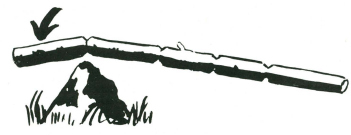
Breaking dead wood is easier than chopping.
When splitting wood with an axe blade the best results are obtained by driving the blade of the axe into the block of wood, then raising both axe and wood, and by reversing the axe head in the air, bringing the axe head down with the wood upermost. One blow in this manner will generally open the toughest block, provided it is not knotty.
After wood has been cut for the cooking fire it is good practice to stack it in graded heaps, little, medium, and big sticks separately, beside the fireplace, with fine twigs and thin slivers in a separate stack.
WOODSHED
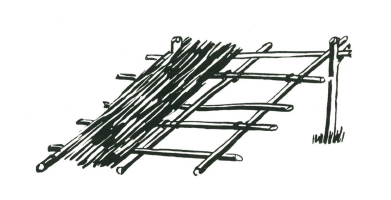
And finally, you will want to be prepared against a spell of wet weather, and so you’ll need a small woodshed. Only then will there be a supply of dry kindling and wood after heavy rain.
The ground dimensions of your woodshed should be at least three feet by four, and about three feet high at the front. It should be to windward of your fireplace, so that windblown sparks will not fall on dry bark or other tinder.
LIGHTING FIRE WITHOUT MATCHES
DIRECT FLAME, using sugar and permanganate of potash crystals, probably carried in the first-aid kit) mix together, and place in a hollow cut in a piece of dry wood. This hollow must be big enough to hold the whole of the dry mixture. Round off a straight stick, about 3/8 to ½” thick and 12” long to a shallow point. Place this end of the stick in the powder and rotate the stick rapidly between the two hands. The mixture will burst into a slow flame. Several attempts may be necessary to obtain ignition. This method may not be effective in damp or cold weather.
SPARK
Iron, iron pyrites and steel used with flint and also some of the very hard stones such as quartz will strike a strong spark, from which it is possible to get a spark for fire. The vital spark for fire-making may also be obtained by friction using a drill and bow, by a magnifying glass which concentrates the sun’s rays, and by compression of air, which concentrates the heat. In the sequence of fire lighting without matches the first step is to get the spark, then from the spark to a coal and lastly from a coal to flame. The spark must be taken onto a tinder, and therefore the preparation of the tinder is a highly important part of fire-making.
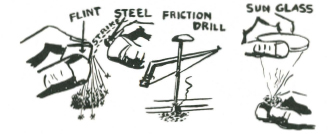
TINDERS AND THEIR PREPARATION
The principle required from a tinder is that it must be readily combustible and finely fibred.
A simple test of natural, that is unprepared, tinder should be made to discover which materials are suitable. To make the test take a loosely teased handful of the material, place a coal from the fireplace in the material and blow. If the fire from the coal extends to the tinders it can be regarded as suitable.
Natural tinders are generally found in dry, beaten grass, finely teased bark, and palm fibre. Most of these coarse tinders are improved in their ability to take and hold a spark by being beaten and pounded until the fibres are fine and soft.
Natural fire-catching properties of tinders can be improved by the addition of a light dusting of very finely ground charcoal or, better still, by being thoroughly scorched.
If saltpetre is available a little may be mixed with the charcoal before it is added to the tinder, or the tinder itself can be soaked in a solution of saltpetre and water and allowed to dry out before use.
Tinder impregnated with a solution of saltpetre and later dried must be carried in an airtight container. If carried otherwise the saltpetre will become damp with moisture from the air. With this, or other prepared tinders you always have an emergency means of getting fire.
Old cotton or linen rag, scorched black and teased, is among the best of all tinders. A pinch of this, placed where the spark will fall, is certain to take the spark and quickly become a glowing coal.
Usine these tinders, lighting fire from spark is comparatively easy.
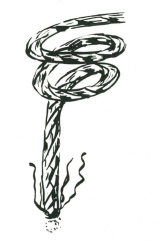
Note. You will discover that some of the soft inner barks, teased and spun into cord, will smoulder slowly when lighted. This is called a ‘slow match.’ It is worth while identifying the plants whose bark have this property. Lengths of cord made from such bark can be used to maintain a ‘coal’ for a long length of time, and so save your precious matches.
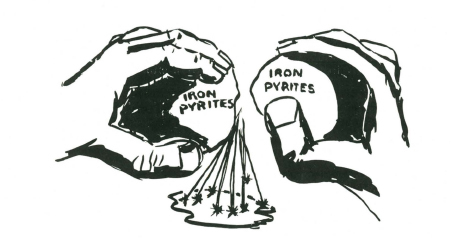
Striking fire from iron pyrites or quartz.
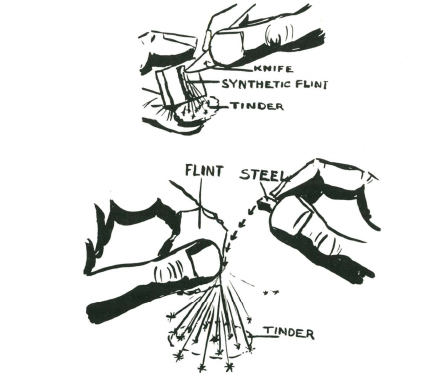
How to strike fire from flint and steel onto tinder.
STRIKING A SPARK
Flint and steel, of course, were the common method of lighting a fire before friction matches were perfected and no great skill is needed for their use. The svnthetic flint used in a cigarette lighter is a considerable improvement on natural flint. A couple of pieces of synthetic flint pressed into a small piece of ‘perspex’ make an excellent emergency firelighting outfit (heat the perspex and press the flints in while it is hot. Hold under cold water and the perspex will shrink on the flints and hold them securely).
An alternative to flint and steel are two pieces of iron pyrites, which, when struck together, throw off a shower of hot sparks that will last for at least a second. Iron pyrites is a common crystalline formation, and not difficult to obtain. Iron pyrites and steel will also give a hot spark. Quartz and steel, or two pieces of quartz, will also strike off good sparks, but these latter stones are very much harder to use.
The sparks struck must fall on the tinder, which, in turn, must be blown into a coal, and from the coal to a flame. Only a pinch of tinder is required when you are proficient with striking a spark.
FIRE BY FRICTION
Firelighting by friction consists first in generating a spark or tiny coal, and then nursing this (in the tinder) to flame.
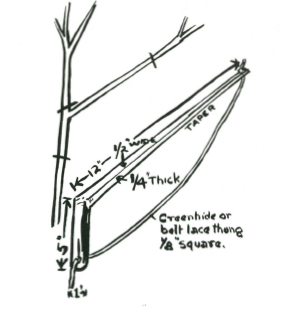
Bow. Thong is made from a leather lace or a strip of greenhide belt lacing.
Firelighting by friction is most easily mastered by the rotation of a drill or spindle in a foot piece. The drill, with some native people, is rotated between the hands but this requires considerable skill. Other primitive people rotated the spindle by means of a bow and thong. This last is the easiest method. The components, which should be prepared beforehand, are a bow, headpiece, drill, and footpiece. The dimensions given below are a guide for size.

To use a fireset, the drill is put under the thong, and twisted so that the drill finally is on the outer side of the thong, and with that portion of the thong nearest the handle of the bow on the upper side of the drill. This is important.
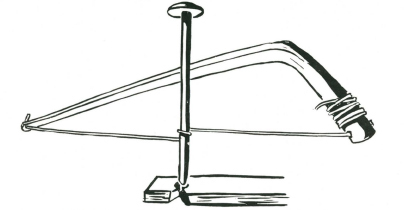
This is how the thong must be round the drill. If the thong is wrong way on the drill it will cross over itself and cut in a few strokes, also the full length of the stroke cannot be obtained.

The foot piece has a shallow hole cut with a knife point into the upper side about half an inch from one edge. In this hole the drill is rotated. Into the edge of this hole from the nearest side, an undercut V is made.’This should be at least one-eighth inch into the hole itself.